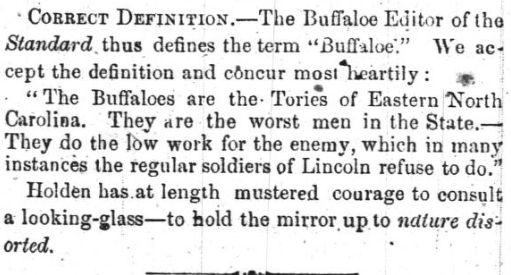In a letter written on October 13, 1862, Unionist J.A. Hedrick reported that a group of North Carolina Union Volunteers looked “first-rate with their sky-blue pants and dark blue coats and hats on. I believe that they make a better appearance than the Yankee soldiers do. Their uniforms make them appear so large that the people call them ‘Buffaloes’ I think that they like to be called buffaloes. They go about in gangs like herds of buffaloes.”
By the winter of 1862, Wingfield plantation, located north of Edenton along the Chowan River, was a base of buffalo operations. It was apparently so well fortified that it took three attacks by local confederate forces to penetrate the camp, which reportedly provided refuge for Confederate deserters, freedom seekers, and Union sympathizers throughout the northeastern corner of the state.

In a February 1864 letter to the editor from the Wilmington Journal, one citizen passed along that “the terms ‘Copperhead’ and ‘Buffalo’ are synonymous; the Coppers being as cordially hated by the yankees as are the Buffs by us. There are not so many Buffalos among us as there are Copperheads among the Yankees.” The author goes on to postulate to the origins of the term, stating that the term originally described those who spoke boldly of their desire to “slaughter” Union troops, but when it came time to enlist in the Confederacy “were the very first to turn tail and run on the approach of danger” and would go on to be referred to as exempts or conscripts. The author then states that buffalo’s meaning had evolved to describe “Union shriekers and those who volunteered in the Yankee service.”
A Unionist song titled "The Buffalo War Song" was reportedly penned by a North Carolinian and published in the New Bern Progress on March 29, 1864. The lyrics lament, “Full well do we know that our case is aright/ on the dear native soil of our father’s we fight/ to defend the Republic is all that we ask/ and freely we give our lives to the task.”
In February of 1864, Confederate Generals George E. Pickett and Robert F. Hoke attempted to recapture New Bern with a secondary goal of capturing Union and buffalo soldiers rumored to be deserters of the Confederate ranks. While Pickett and Hoke were unsuccessful in reclaiming New Bern, they did capture 53 members of the 2nd North Carolina Union Volunteer Regiment. Twenty-two of those captured were issued a court-martial for desertion from the Confederate army – the validity of which was questionable for many of the court-martialed prisoners – Pickett marched the men west to Kinston, where most of them had lived. There he ordered them to be hanged in front of their wives, children, and neighbors, despite the fact that public hanging was not standard for military execution.
According to a June 4, 1864 article from The Confederate, “buffaloes” cried out for peace alongside Governor Vance.
Some historians, however, proposed that buffalo was a strictly pejorative term to describe men in the South who would not fight for the Confederacy or supported the Union, with earlier historians emphasizing that buffaloes were lawless, violent, and disorganized.
Richard Benbury Creecy, a pro-secession newspaper editor from Elizabeth City, relayed a story that explained the term originated because men who refused to fight for the Confederacy "had no horns," like a female buffalo, and that they "could not be roped." With this implication, Unionists described as "buffaloes" were believed to be weak, unruly and unhelpful. This definition was further solidified with the work of historians John W. Moore, Joseph Gregoire de Roulhac Hamilton, and Daniel H. Hill Jr. which ascribed exclusively negative, often lawless, characteristics to "buffaloes." These additional characteristics included a taste for violence, thievery, and an overall moral deficit. Hill argued that Unionists had coined the term with derision, and much of his research emphasized this lawlessness of buffaloes while omitting information from the same sources that would have supported a more expansive view of the term’s meaning. Hill’s research has been critiqued by modern historians as being inconsistent with respect to dates, events, and people present. Hill's definition of Buffaloes as published in his 1926 Bethel to Sharpsburg: A History of North Carolina in the War between the States expanded the definition to include Southerners with pro-Union views, instead of just Unionist soldiers in NC.
"Buffalo" was not publicly examined again until the 1960s, when historians F. Roy Johnson, Thomas C. Parramore, and John Gilchrist Barrett added to the etymology of "buffalo." Their additions reinforced that "buffaloes were violent and cowardly," although there are many sources from the Civil War era that used the term without these implications. Modern historians have also noted other inconsistencies and inaccuracies in their citations and attributions of dates.
"Buffalo'' remained unexplored again until the 2000s, when historian Judkin Jay Browning researched the term and its origins. Browning's appraisal is more expansive than previous works, but still featured pieces of Hill's since disproven claims. In 2008, Alex Christopher Meekins explored the term's history more comprehensively, and attempted to find an ultimate meaning or origin. He also identified gaps and oversights in other historians' work on the topic.
The absolute meaning and origin of the term remains uncertain.